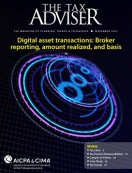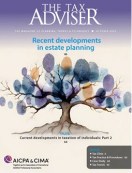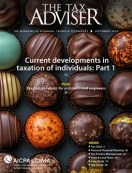- column
- credits against tax
The R&D tax credit for architects and engineers
Architecture and engineering firms often face challenges when seeking to claim the Sec. 41 research-and-development tax credit for their work on building and construction projects, as two recent court cases illustrate. However, by understanding the requirements to claim the credit and carefully planning, executing, and substantiating a project, they may be able to qualify for it.

Related
Notice 2025-27 provides interim guidance on corporate AMT
Two Tax Court rulings expose overvalued conservation easements
Late election relief in recent IRS letter rulings
The Sec. 41 research-and-development (R&D) tax credit has long been an important incentive for businesses engaged in innovative activities. For architects and engineers, whose work often straddles the line between applied science and technical design, the credit represents a potential boon — yet one that remains maddeningly elusive. Two cases decided in 2024, Meyer, Borgman & Johnson, Inc.,1 and Phoenix Design Group, Inc.,2 underscore the issue. These decisions highlight what constitutes “qualified research” and illuminate persistent pitfalls for architecture and engineering (A&E) firms seeking the credit. This article delves into these cases, exploring their implications for the building and construction industry, and concludes with practical strategies for architects and engineers to navigate the funded research, Sec. 174, and process-of-experimentation hurdles, buoyed by a hopeful note from the Tax Court’s denial of summary judgment for the IRS in a pending case, Smith.3
Blueprint of denial: Meyer, Borgman & Johnson, Inc.
In Meyer, Borgman & Johnson, Inc., the Eighth Circuit affirmed a Tax Court summary judgment ruling that denied approximately $190,000 in R&D tax credits claimed by Meyer, Borgman & Johnson (MBJ), a structural engineering firm, for tax years 2010, 2011, and 2013. MBJ’s core argument rested on its creation of construction documents for structural designs, which it asserted involved innovative research. The IRS and the courts, however, zeroed in on the “funded research” exclusion as a reason to deny the tax credits. That rule bars a taxpayer from receiving credits for research financed by another party.4 But the funded-research exclusion is inapplicable if payment for the research is contingent on the success of the research; in such circumstances, the party performing the research can claim the R&D credit because it bears the risk of failure. Thus, to resolve the tax credit issue here, the court needed to decide whether this was a situation where payment for the research was contingent on the success of the research.
MBJ’s contracts were fixed-price agreements, a structure it argued placed it at financial risk if its designs failed to meet client expectations — akin to the contingency upheld in Fairchild Industries, Inc.5 The Eighth Circuit disagreed, distinguishing MBJ’s situation from Fairchild. In Fairchild, payment hinged on meeting over 1,000 pages of precise technical specifications, with progress payments refundable if benchmarks were not met. MBJ’s contracts, by contrast, demanded adherence to general professional standards — delivering designs compliant with codes and suitable for construction — but lacked explicit language tying payment to the success of research activities. The Eighth Circuit, in making its determination, relied on cases including Geosyntec Consultants, Inc.6 and Grigsby,7 which clarified that “proper performance” under a standard of care differs from “successful performance” contingent on research outcomes. Even MBJ’s phased contracts, with client approvals at milestones, fell short of the specificity required to shift the risk to MBJ.
The ruling underscores a critical lesson: Fixed-price contracts alone do not render research “unfunded.”8 Courts demand contractual provisions that explicitly link payment to the success of the research itself, not merely to the delivery of a serviceable product, as emphasized by the Tax Court’s analysis of MBJ’s lack of refund clauses or rigorous acceptance criteria. For MBJ, this absence sealed its fate, leaving its innovative efforts unrewarded by the R&D credit.
Structural collapse: Phoenix Design Group, Inc.
Raising a different set of issues, Phoenix Design Group, Inc., offers a more exhaustive dissection of the R&D credit’s four-part test under Sec. 41(d)(1) for qualified research.9 Phoenix Design Group (PDG), a multidisciplinary engineering firm specializing in mechanical, electrical, plumbing, and fire protection (MEPF) systems, claimed credits for over 200 projects from 2013 to 2016. The Tax Court examined a nonbinding sample of three projects — Gerald Champion Military Psychiatric Unit (Gerald Champion), Baptist Memorial Health North Mississippi Oxford (BHNM Oxford), and Vanderbilt University Engineering and Science Building (VU ESB) — ultimately denying credits for all, with accuracy-related penalties upheld per the parties’ stipulation.
Unlike in Meyer, Borgman & Johnson, the IRS in Phoenix Design Group conceded the technological-information and business-component prongs, focusing instead on the Sec. 174 test and the process-of-experimentation test. The Sec. 174 test requires that expenditures qualify as research-and-experimental (R&E) costs deductible under Sec. 174, meaning they must address objective uncertainty about a product’s capability, method, or design through investigative activities.10 PDG argued that uncertainties persisted in integrating new MEPF systems with existing ones (Gerald Champion), designing MEPF systems for a new hospital (BHNM Oxford), and designing MEPF systems for a new building without the specific use of each portion of the building having been determined (VU ESB). The court, however, found PDG’s evidence lacking. Initial schematic diagrams and client-provided data often resolved basic design uncertainties, and PDG failed to demonstrate how subcomponent uncertainties (e.g., heating, ventilation, and air conditioning (HVAC) placement or equipment selection) rendered the entire MEPF system’s design uncertain.11 Moreover, PDG’s reliance on routine calculations and third-party decisions — rather than independent investigative efforts — further undermined its case.
The process-of-experimentation test proved an even higher hurdle.12 This requires that substantially all (80% or more) research activities involve a scientific-method-like evaluation of alternatives to resolve design uncertainty.13 PDG touted its six-stage design process as evidence of experimentation, but the court dismissed this as superficial. Hour sheets revealed inconsistencies — engineers logged time under vague descriptors like “design” or “project coordination” misaligned with the alleged stages. Specific examples, such as selecting a variable air volume system for Gerald Champion or designing diffusers for BHNM Oxford’s hybrid operating room (OR), lacked documentation of iterative testing or hypothesis evaluation. Instead, PDG engineers relied on expertise and client directives, falling short of the rigorous experimentation standard articulated in Union Carbide Corp.14
The court’s application of the shrinking-back rule — assessing subsystems like mechanical or electrical designs when the whole MEPF system failed the four-part Sec. 174 test — offered no reprieve.15 Sparse hour logs and unexplained design drawings left the court unable to verify whether discrete activities met the credit’s criteria, highlighting that a taxpayer must substantiate its claims meticulously.
Raising the bar: Implications for the industry
Together, Meyer, Borgman & Johnson and Phoenix Design Group signal how courts may interpret the R&D credit for architects and engineers. Meyer, Borgman & Johnson addresses the funded-research exception, emphasizing that contractual risk must explicitly tie payment to research success, not just project completion. Phoenix Design Group underscores the substantive hurdles of Sec. 174 and experimentation, demanding clear evidence of uncertainty and scientific rigor beyond basic calculations. These cases reflect a broader skepticism about applying the credit to design work, echoing sentiments in Little Sandy Coal Co.,16 where testing to meet customer specifications did not qualify as developmental research.
For A&E firms, the stakes are high. Their work often involves solving complex, site-specific problems — be it MBJ’s structural designs or PDG’s MEPF system designs — yet the petitioners failed to persuade the court that investigative activities occurred. The reliance on client specifications, building codes, and preexisting data further blurs the line, positioning, in the court’s eyes, much of their activity as “proper performance” rather than “successful performance.” This judicial lens disadvantages an industry whose incremental advancements underpin modern infrastructure, prompting a need for strategic adaptation.
Building a stronger foundation: Practical techniques
To navigate this landscape, architects and engineers must adopt proactive measures tailored to the funded-research, Sec. 174, and process-of-experimentation challenges illuminated by Meyer, Borgman & Johnson and Phoenix Design Group. These strategies aim to align their practices with the credit’s stringent requirements, enhancing their prospects of success.
On the funded-research front, firms that seek to claim the R&D credit should scrutinize their contracts with an eye toward contingency.17 Fixed-price agreements, while common, must go beyond general performance standards if the credit is sought. Drawing from Meyer, Borgman & Johnson, contracts should include explicit clauses making payment contingent on achieving specific research milestones — e.g., a design phase’s success in resolving a novel structural uncertainty, verified by client acceptance of detailed technical benchmarks.18 Provisions for refundable progress payments or rejection rights tied to research outcomes, as seen in Fairchild, can further shift financial risk to the client, distancing the work from the “funded” label. Negotiating contracts with such terms may require educating clients about the R&D credit, but the payoff in tax credits could justify the effort.
Addressing the Sec. 174 test demands a cultural shift in documentation.19 PDG’s downfall lay in its failure to pinpoint objective uncertainties and link them to investigative efforts. Firms should maintain contemporaneous records — modeling and simulation iterations, project logs, memos, or engineer notes — detailing what information was unavailable at a project’s outset (e.g., unknown load capacities or system integration challenges) and how it impacted the design’s feasibility.20 These records should then chronicle specific investigative steps — site assessments, modeling and simulations performed, or consultations with manufacturers — to resolve those unknowns, distinguishing them from routine basic calculations.21 For instance, PDG could have documented initial HVAC sizing uncertainties and subsequent airflow analyses as distinct from standard code compliance. This granular approach might help in satisfying Sec. 174 and counter a court’s skepticism about systemic uncertainty.
The process-of-experimentation test, perhaps the toughest nut to crack, requires firms to emulate the scientific method explicitly.22 Rather than leaning on expertise or client choices, as PDG did, engineers should hypothesize multiple design solutions — say, alternative chiller configurations or duct layouts — and test them through models, simulations, prototypes, or field trials.23 Each iteration should be logged with quantitative outcomes (e.g., energy-efficiency metrics or pressure differentials), showing a systematic evaluation of alternatives.24 Time-tracking systems must evolve beyond vague entries like “design”; instead, allocate hours to specific experimental tasks (e.g., “tested diffuser placement for hybrid OR airflow”). Software modeling and simulation tools can aid this, generating reports that substantiate the 80% threshold for “substantially all” activities. PDG’s VU ESB steam pipe stress analysis, with its iterative software modeling, came closest to this ideal — had it been better documented, it might have swayed the court.
In addition, firms should leverage the shrinking-back rule as a safety net.25 If a project’s entirety does not qualify, firms should isolate subsystems or discrete challenges — like MBJ’s structural supports or PDG’s fume hood exhausts — and document them as stand-alone research efforts. This requires segregating time and costs by component, ensuring each meets the four-part test independently. While labor-intensive, this tactic makes use of the court’s willingness to drill down, offering a fallback when holistic claims falter.
Sec. 174 immediate expensing restored
Finally, it should be noted that Section 70302 of H.R. 1, P.L. 119-21, (commonly known as the One Big Beautiful Bill Act), repealed the requirement under the Tax Cuts and Jobs Act, P.L. 115-97, that all domestic R&E expenditures be amortized over 15 years rather than deducted in the tax year incurred (amortization still applies to foreign R&E). New Sec. 179A reverses that provision for domestic R&E expenditures incurred after Dec. 31, 2024. In addition, eligible taxpayers (those meeting the small business gross-receipts test of Sec. 448(a)(3), i.e., with average annual receipts for the three tax years prior to 2025 of $31 million or less) may elect expensing treatment retroactively to expenditures incurred after Dec. 31, 2021.
Thus, it is even more important for A&E firms to craft precise contracts, substantiate uncertainties, and embrace experimentation.
A hopeful note
A more positive recent development is the Tax Court’s Dec. 18, 2024, order in Smith, where the court denied the IRS’s motion for summary judgment against Adrian Smith + Gordon Gill Architecture LLP (AS+GG) in a case involving whether the firm was eligible for the R&D credit.26 This decision indicates that architects and engineers have a chance to claim the credit if they can build their case with care.
In Smith, the court declined to rule summarily that AS+GG’s work on six ambitious projects — including the world’s-highest Kingdom Tower now under construction in Saudi Arabia and the eco-innovative Masdar Headquarters complex in the United Arab Emirates (placed on hold and never completed) — constituted funded research under Sec. 41(d)(4)(H). The IRS argued that AS+GG relinquished substantial rights in the research and faced no financial risk tied to research success, echoing Meyer, Borgman & Johnson. AS+GG countered with contract terms retaining intellectual property rights and tying payments to milestone approvals, bolstered by foreign copyright laws that might preserve their stake in the research. The court’s refusal to dismiss these claims on summary judgment suggests that courts may yet reward firms that meticulously document their risk and rights retention.
This glimmer of optimism doesn’t remove the hurdles. Architects and engineers who seek to claim the R&D credit must still craft contingency-laden contracts — explicitly linking payment to research outcomes, as Smith’s milestone-based payments suggest — while documenting uncertainties and iterative testing with scientific rigor.27 AS+GG’s approach, leveraging retained copyrights and phased approvals, offers a model: Firms can negotiate terms that shift risk back to themselves, preserving their claim to the credit. Detailed logs of investigative efforts and experimental design iterations remain essential, as Phoenix Design Group painfully demonstrated.
In addition, none of the adverse cases included a taxpayer who included a Loper Bright argument. The recent Loper Bright decision puts into question many of the administrative hurdles and tests the IRS has added to the R&D tax credit area that are not directly part of the tax law.28
The path forward is neither wide nor easy, but it is not yet sealed shut. By aligning their practices with the guideposts discussed above — crafting precise contracts, substantiating uncertainties, and embracing experimentation — firms can erect a defensible framework for the R&D credit.29 The Smith case may provide further clarity; it went to trial in March 2025 but the Tax Court has not issued a decision as of this writing. For an industry built on precision and innovation, this challenge is surmountable. With diligence and foresight, architects and engineers can turn a once-distant credit into a tangible reward for their creative and technical prowess.
Footnotes
1Meyer, Borgman & Johnson, Inc., 100 F.4th 986 (8th Cir. 2024).
2Phoenix Design Group, Inc., T.C. Memo. 2024-113.
3Smith, T.C. Nos. 13382-17, 13385-17, and 13387-17 (order 12/18/24).
4Sec. 41(d)(4)(H); Regs. Sec. 1.41-4A(d)(1).
5Fairchild Industries, Inc., 71 F.3d 868 (Fed. Cir. 1996).
6Geosyntec Consultants, Inc., 776 F.3d 1330 (11th Cir. 2015).
7Grigsby, 86 F.4th 602 (5th Cir. 2023).
8Citing Grigsby, 86 F.4th at 619.
9The expenditures (1) must be treated as specified research or experimental expenditures under Sec. 174; of research undertaken (2) for the purpose of discovering information that is technological in nature; (3) the application of which is intended to be useful in developing a new or improved business component of the taxpayer; and (4) substantially all of the activities of which constitute elements of a process of experimentation for a purpose of a new or improved function, performance, reliability, or quality.
10Sec. 41(d)(1)(A); Regs. Sec. 1.174-2(a)(1).
11Citing Betz, T.C. Memo. 2023-84 at *76.
12Sec. 41(d)(1)(C).
13Regs. Secs. 1.41-4(a)(5)(i) and (a)(6).
14Union Carbide Corp., T.C. Memo. 2009-50.
15Regs. Sec. 1.41-4(b)(2). If the Sec. 41(d) and Regs. Sec. 1.41-4(a) requirements are not met at the level of a discrete business component, they may “shrink back” to the level of the most significant subset of elements of the product, process, computer software, technique, formula, or invention to be held for sale, lease, or license.
16Little Sandy Coal Co., T.C. Memo. 2021-15, aff’d, 62 F.4th 287 (7th Cir. 2023).
17Sec. 41(d)(4)(H); Regs. Sec. 1.41-4A(d)(1).
18See Fairchild, 71 F.3d at 870–73.
19Sec. 41(d)(1)(A); Regs. Sec. 1.174-2(a)(1).
20See Regs. Sec. 1.174-2(a)(1); Max, T.C. Memo. 2021-37 at 29–30.
21See Max, T.C. Memo. 2021-37 at 30.
22Sec. 41(d)(1)(C); Regs. Sec. 1.41-4(a)(5)(i).
23See Union Carbide, T.C. Memo. 2009-50, slip op. at 201.
24Regs. Sec. 1.41-4(a)(5).
25Regs. Sec. 1.41-4(b)(2).
26Smith, T.C. Nos. 13382-17, 13385-17, and 13387-17 (order 12/18/24).
27Regs. Sec. 1.41-4A(d)(1).
28Loper Bright Enterprises v. Raimondo, 144 S. Ct. 2244 (2024), overturning Chevron deference to federal administrative rulemaking; see Beavers, “Supreme Court Overturns Chevron Doctrine,” 55-9 The Tax Adviser 68 (September 2024).
29Regs. Sec. 1.41-4A(d).
Contributors
Charles R. Goulding, CPA, J.D., MBA, is president and founder, and Jacob Goldman, MBA, is vice president and chief engineer, both of Energy Tax Savers Inc. in Syosset, N.Y. For more information about this article, contact thetaxadviser@aicpa.org.
MEMBER RESOURCES
Articles
Shodhan et al., “The Research Credit: Adaptation Exclusion,” 55-6 The Tax Adviser 38 (June 2024) Frost et al., “The Research Credit: Funded Research,” 54-3 The Tax Adviser 11 (March 2023)
Conference
AICPA & CIMA National Tax Conference, Nov. 17–18, Washington Hilton, Washington, D.C., and live online
CPE self-study
Capitalized Costs & Depreciation — Tax Staff Essentials
For more information or to make a purchase, visit aicpa.org/cpe-learning or call 888-777-7077.














